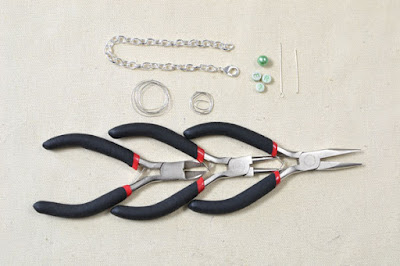Hello friends! Today, I present you an exciting tutorial of crafty lampwork beads that are so dear to us. It is indeed a pleasure in making handcrafted jewelry and now we are getting ahead with subtle designs and other combinations of jewelry.
It is a pretty easy project to pursue if you are a beginner. I would say, spare about 30 minutes of your time and approximately $20 from your pocket money. You will need to collect some supplies and cost of each varies from store-to-store.
Following are the materials you require to handcraft your beautiful earrings:
· *Lampwork beads – 2x, round in shape, medium size, red colored
· *Earring components – 2x, leverbacks, posts or French hooks
· Sterling silver or 14 Carat Gold wrapping wire
· Headpins – 2x
· Daisy spacer beads – 2x
· Nylon-jaw pliers
· Round-nose pliers
· Flat-nose pliers
*I personally like red lampwork beads, so I mentioned them to use here. You can also choose gold or silver if you like.
*Leverbacks are generally practical with longer or heavier jewelry designs. If you prefer French hooks then fix a rubber stopper to them in order to prevent them from sliding down. You know the drill!
Start by creating the frame with lampwork beads: grab a headpin and string your beads and one daisy spacer. Followed by, form a basic type of loop.
Now, take your gold or sterling silver wire and work about 6” of its length. Use your nylon-jaw pliers to straighten the bent shape of your wire. Do it gradually and neatly; you do not want your wire to deform or break into pieces. Wires are delicate, do remember.
Then, about one end of your wire, form a loop and fix one bead into this loop. Work with your round-nose pliers, carefully form a squiggly design of your wire by bending it back and forth neatly – it should be fun.
The length of this squiggle depends on your preference; make few squiggles for a short length or many for a longer length. As a general recommendation, I say you keep your wiggles about an inch long.
Use your flat-nose pliers and bend your wire on the opposite ends about a right-angle shape. Create another loop as you did of the other end of your wire. You can choose to stern your wire slightly by squeezing your squiggled wire component neatly and gently using your nylon-jaw pliers, but this is not a hard-and-fast rule. Repeat the same squiggling and forming loop for your other piece of earrings.
Now fix this finished piece to your earring component that you choose with the help of flat-nose pliers. Your earrings are ready!
That was surely it. You must be pleased how simple and comprehensive every detail was about each step. I understand certain processes require practice, but who said you could be an expert on your first attempt? No one ever!
These lampwork beads earrings are a splendor to wear; fun and amusing for others to spot. Stay tuned for more exciting jewelry tutorials.




























